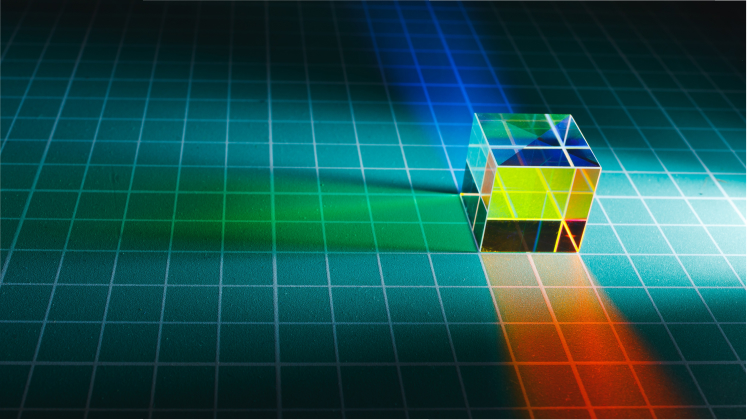Hyperspectral cameras: principles, operation and applications in advanced observation
What are hyperspectral cameras and how does this technology work?
Can you imagine being able to see what the human eye cannot perceive? Hyperspectral cameras make possible what we once could only dream of: seeing beyond the visible. This innovative technology captures information across a wide range of the electromagnetic spectrum, breaking light down into dozens or even hundreds of spectral bands, far beyond the colours perceived by humans. In effect, these cameras create a snapshot that overlays layers of different electromagnetic frequencies – from the lowest in the infrared range to the highest in the ultraviolet, passing through an extensive span of visible frequencies.

October 2025

Approximately 5 minutes

Hyperspectral cameras are advanced imaging devices that capture information across a broad range of the electromagnetic spectrum. To achieve this, they split light into dozens or even hundreds of contiguous, narrow spectral bands.
Unlike conventional or multispectral cameras, which capture only a few bands, hyperspectral cameras generate a hyperspectral data cube: a three-dimensional representation that combines two spatial dimensions with one spectral dimension. Each pixel in the image contains a complete spectrum, enabling the identification of materials and objects according to their unique spectral signature
How does a hyperspectral camera work?
This technology works by using optical elements such as prisms or diffraction gratings to disperse light, and it can operate under different scanning modes: spatial, spectral or snapshot capture. Its spectral precision enables a wide range of specialised applications, from precision agriculture and environmental monitoring to mineral detection, quality analysis in the food industry and security and defence surveillance. In the electricity sector, these cameras open new opportunities for advanced grid management: from inspecting transmission and distribution lines and identifying hotspots or encroaching vegetation, to monitoring the condition of substations, renewable facilities and water basins. They support predictive maintenance that improves service continuity and strengthen the transition towards a more efficient and resilient energy system.
From the visible spectrum to the hyperspectrum: the basis of hyperspectral vision
Hyperspectral vision is transforming the way we perceive the world around us, going beyond the limits of the visible spectrum and venturing into a new dimension of imaging that extends far beyond the colours our eyes can distinguish.
While traditional cameras capture images based only on three primary colours – red, green and blue – hyperspectral cameras can obtain an infinitely richer range of data. Equipped with advanced sensors, these cameras split incoming light into multiple spectral bands, gathering information across hundreds of wavelengths – some even beyond human vision, such as ultraviolet or near infrared.
What makes hyperspectral vision remarkable is that it does not simply provide a visual representation of what we see but also reveals the composition of objects. Each pixel of a hyperspectral image becomes a data source showing how light interacts with materials, making it possible to identify not only what is visible, but also what cannot be seen by the naked eye.
The amount of information stored in each pixel is no longer expressed as Pixel n = [R, G, B] but as Pixel n = [f1, f2, f3, …], greatly increasing the ability to extract data from the interaction of different frequencies. Just as purple in a conventional camera is mainly measured by the presence of red and blue and then interpolated between the two, the great advantage of hyperspectral cameras lies not only in the additional bands captured, but also in the much greater precision of the interpolation between them. In other words, the tone of the colour purple is measured in a far more accurate and consistent way.
This leap from the visible spectrum to the hyperspectrum is not only a technological advance but also a revolution in the way we understand and interact with the world. The ability to see beyond what the human eye can perceive opens new doors for research, analysis and decision-making, transforming entire industries and improving our ability to tackle complex challenges more effectively.
Hyperspectral vision is no longer just a scientific curiosity but is now a fundamental tool for the present and future across many fields.
Key components and the hyperspectral imaging process
Hyperspectral technology relies on a combination of essential components that make it possible to capture vast amounts of data across multiple spectral bands. At the heart of a hyperspectral camera is a high-resolution sensor capable of splitting light into hundreds of different wavelengths. This sensor generally consists of an optical device, such as a prism or diffraction grating, which disperses the light into different spectra, and a detector that records the intensity of light in each band.
What’s more, to ensure image accuracy and clarity, hyperspectral cameras also include calibration systems that adjust the sensor’s response to environmental conditions, delivering reliable data under all circumstances.
The process of hyperspectral image acquisition begins by illuminating the object or area of interest, either with natural or artificial light. The light reflected by the objects is captured by the camera’s sensor, which disperses it into its various wavelengths to generate a three-dimensional “data cube”. Each layer of this cube represents an image of the scene at a specific spectral band. As a result, each pixel in the image contains not only spatial information about the scene but also detailed spectral data, allowing highly precise analysis of material properties.
This process is repeated across multiple wavelengths, producing a set of images that, when combined, form a unique spectral profile for each observed object. The ability to capture and analyse this spectral data enables more accurate material identification and a deeper understanding of characteristics that are invisible to the naked eye.
The result is a high-resolution image that is not only visually accurate but also enriched with information. However, the complexity of this process requires the acquired images to be processed and analysed using specialised algorithms, which make it possible to extract the true value of hyperspectral information and apply it across the various sectors where this technology is used.
Main applications of hyperspectral cameras
Hyperspectral cameras have a wide range of applications across different sectors, standing out for their ability to provide detailed information beyond what the human eye can perceive.

Photovoltaic cells
Photovoltaic cells: discover their evolution, their different types and the latest innovations.

What’s a data center?
Data processing centers have become fundamental for all organisations.

Virtual batteries
Virtual batteries have emerged in the energy market as a practical and sustainable alternative.

What is Artificial Intelligence?
Are we aware of the challenges and main applications of Artificial Intelligence?
Benefits and advantages of hyperspectral cameras
Hyperspectral cameras offer a series of benefits and advantages that make them indispensable across a wide range of fields. Their ability to capture information at multiple wavelengths produces far more detailed images than conventional cameras, enabling deeper and more accurate analysis of objects and their environment.
Hyperspectral cameras in the electricity sector
At a time when the electricity sector is advancing towards smarter, more sustainable and more resilient grids, technological innovation has become a key driver. Among these innovations, hyperspectral cameras stand out as a tool capable of transforming the way critical infrastructure is monitored and managed.
Through their ability to “see the invisible”, these cameras capture detailed information that goes beyond the visible spectrum, enabling the early detection of wear, hotspots in high-voltage lines, corrosion to towers and equipment, or even vegetation that could threaten supply continuity. This level of precision paves the way for predictive maintenance strategies that reduce costs and increase the reliability of the electricity system.
The energy transition also benefits from this technology: from analysing the condition of solar panels to inspecting wind turbines, hyperspectral cameras provide valuable data to optimise the performance of renewable energy assets. Their integration with artificial intelligence systems and remote monitoring allows for faster and more effective responses to any incidents, thereby strengthening the security and efficiency of the entire grid.
In short, applying this technology in the electricity sector not only improves operations and reduces risks but also contributes to building a more sustainable and innovative energy system, aligned with the challenges of the future.
Other innovative applications of hyperspectral vision
Environmental monitoring and pollution detection
Hyperspectral technology is becoming a key tool for environmental monitoring, providing a detailed and accurate view of environmental parameters that are difficult to observe using traditional methods. Thanks to their ability to capture information across hundreds of spectral bands, hyperspectral cameras can detect invisible variations in the environment, such as the presence of pollutants or the quality of air and water.
For pollution detection, hyperspectral cameras can identify toxic substances or pollutants in water, soil and the atmosphere. For example, they can detect heavy metal contamination in rivers or the presence of chemical pollutants on the surface of water. In the air, they are valuable for monitoring greenhouse gases such as carbon dioxide or volatile organic compounds, contributing to air-quality monitoring and climate change tracking.
Another important capability is the detection of changes in vegetation, which may indicate environmental stress caused by pollution. By observing the spectral behaviour of plants, it is possible to identify the impact of factors such as air pollution or the build-up of heavy metals in soil. This type of early monitoring is essential to prevent further ecosystem damage and to support the implementation of more effective conservation and restoration policies.
Industrial inspection and quality control through hyperspectral analysis
Hyperspectral analysis is gaining ground in industrial inspection and quality control thanks to its ability to provide detailed, non-invasive analysis of products and materials in factories and production lines. By capturing images across a wide range of wavelengths, these cameras can identify variations in material properties that are invisible to the naked eye, enabling the detection of defects or irregularities in products.
In the food industry, for example, hyperspectral cameras are used to inspect product quality, determining ripeness, identifying defects in fruit and vegetables or even detecting contaminants such as pesticides or bacteria. This type of analysis is essential to ensure the safety and quality of products before they reach the end consumer.
In the pharmaceutical and chemical industries, hyperspectral cameras are valuable for verifying the composition and homogeneity of ingredients in manufacturing processes. This helps ensure products meet quality standards and prevents cross-contamination on production lines.
In the manufacture of materials such as metals, plastics or textiles, hyperspectral analysis can detect structural imperfections, such as cracks or inconsistencies in material density, making it possible to identify defects before products are released to the market.
Using hyperspectral technology in industrial inspection not only improves production efficiency but also reduces waste and the costs of detecting defects post-manufacture, ensuring higher-quality products and reducing risks associated with defective goods in multiple industries.
Industrial inspection and quality control through hyperspectral analysis
Hyperspectral analysis is gaining ground in industrial inspection and quality control thanks to its ability to provide detailed, non-invasive analysis of products and materials in factories and production lines. By capturing images across a wide range of wavelengths, these cameras can identify variations in material properties that are invisible to the naked eye, enabling the detection of defects or irregularities in products.
In the food industry, for example, hyperspectral cameras are used to inspect product quality, determining ripeness, identifying defects in fruit and vegetables or even detecting contaminants such as pesticides or bacteria. This type of analysis is essential to ensure the safety and quality of products before they reach the end consumer.
In the pharmaceutical and chemical industries, hyperspectral cameras are valuable for verifying the composition and homogeneity of ingredients in manufacturing processes. This helps ensure products meet quality standards and prevents cross-contamination on production lines.
In the manufacture of materials such as metals, plastics or textiles, hyperspectral analysis can detect structural imperfections, such as cracks or inconsistencies in material density, making it possible to identify defects before products are released to the market.
Using hyperspectral technology in industrial inspection not only improves production efficiency but also reduces waste and the costs of detecting defects post-manufacture, ensuring higher-quality products and reducing risks associated with defective goods in multiple industries.
Medicine, art and space exploration
Hyperspectral vision is not limited to fields such as agriculture or industry; it is also opening new frontiers in areas as diverse as medicine, art and space exploration.
In medicine, this technology is used to enable more accurate diagnoses, such as the early detection of cancer or the analysis of tissues, by capturing spectral details invisible to the human eye, including blood oxygenation or cellular anomalies. This makes it possible to carry out more detailed and less invasive patient assessments.
In art, hyperspectral cameras are transforming the conservation and restoration of artworks. By analysing pigments and materials under different wavelengths, experts can uncover hidden details in paintings, identify underlying layers of ancient works and study an artist’s technique, all without damaging the original piece.
In space exploration, hyperspectral cameras are used to study the surface of planets, asteroids and moons, providing crucial data about their composition and supporting the search for natural resources or signs of life beyond Earth. These cameras also allow for detailed analysis of planetary atmospheres and geology, enabling more efficient missions with greater discovery potential.
These innovative applications demonstrate how hyperspectral vision is reshaping diverse disciplines, opening new opportunities for science, healthcare, cultural preservation and space discovery.

















